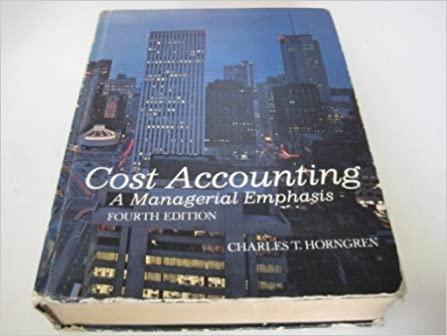Two Plants and Standard Costs The Orose Glass Company is organized into three divisions. The Industrial Glass
Question:
Two Plants and Standard Costs The Orose Glass Company is organized into three divisions. The Industrial Glass Division, headed by Bill Carder, general manager, has seven plants, located in various parts of the United States. The plants are located near the ultimate customers, because competition is very intense. A manufacturer that has to add long-haul freight costs into a bid stands little chance of getting profitable business.
On this particular morning, Bill was talking to two of his plant managers, who supplied adjacent geographical locations in the western part of the country. “A new technique has been developed that will impregnate glass with a special material, AIN. Glass impregnated with this material effectively filters 99.9 percent of harmful rays from the sun, at the same time allowing an observer to determine the color and quantity of the material in the bottle.
“Market research on the product indicates that Orose Glass would not be able to pass on any added cost of this product to the industrial consumer.
However, the research did show that if containers made of the new material were sold at the same price as present containers ($295 per batch), the demand would be heavy. The market forecast is 500 batches. (A batch is 10,000 bottles. )
‘““We want to convert one plant to the new process. We would like it to be one of your plants because of the similarity of your activities. Since you share a common sales force, your sales are just about equal. The operating costs for this product for your two plants are very similar.” (Exhibit 9-9.)

Bill went on to say, “Because of the density of the liquid glass when it contains AIN, a new glass-blowing machine will have to be purchased. However, the rest of the production process can use existing equipment. The cost of the new machine is $50,000, and it has an expected life of 20 years. Straight-line depreciation will be used for internal control and evaluation. The cost of the AIN will be $15 a batch.
“Well, boys, that’s the story,” said Bill. “Why don’t you take a look at the figures and let me know which of you thinks he can make a profit on the new process.”
Jim Cline took one look at the numbers and said, “This baby will cost me a lot of money. Take a look. The full cost to produce a batch is $280.30 (Exhibit 9-10). If we add $15 to that, I am going to lose 30¢ a batch plus the added cost of depreciation. Besides, my denominator variance was unfavorable by $3,787.50 last year, which means my batch cost must be more than $280.30.
No thanks; I don’t want that new process.”
George Atkins pondered the numbers a little longer and said, “I haven’t had time to check all the numbers, but I think this might be a money maker. Let me work on this a while, Bill, and I'll let you know if I want to use it.”
. Who is right, Jim or George?
. If the process is used, how much will profits increase or decrease?
. Explain the $3,787.50 variance that Jim mentioned. Why is it not in Exhibit 9-9? Show computations.

4, Given your answer to 2, assume that the material AIN could go up or down in price over the next few months. At what AIN price would the new process be exactly as profitable as the old (given that sales would be at 500 batches a year)?
Note 1: Old glass-blowing machines are fully depreciated and have no salvage value. The cost of removal is very small.
Note 2: Inventories of products are not maintained. Production is done on a job-order basis in batches of 10,000. Standard costs are determined for batches of 10,000.
Note 3: If one of the plants is converted, all of its current production will be replaced by the new product. That is, there will be no possibility of producing the two different products in one plant.
Step by Step Answer:






